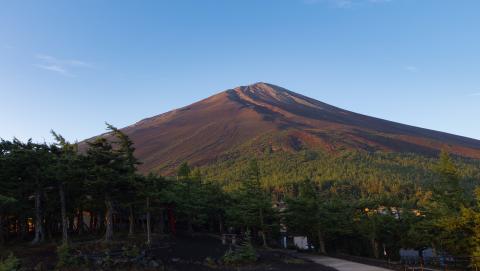Main content starts here.
Home to Mt. Fuji, Yamanashi Prefecture is easily reachable from Tokyo but feels like a world away from the bustle of the capital. Besides Japan’s most sacred mountain, the nature-rich area hosts the picturesque Fuji Five Lakes, the sheltered highland resort of Kiyosato, solemn historical sites such as the Erinji and Kuonji temples, a remarkable variety of hot springs, and some of the country’s best wineries. In short, Yamanashi has everything for travelers seeking to discover a new side of Japan, uncover the true beauty of the country, and recover their sense of wellbeing in the midst of nature.
Find Your New Experience
Whether you’re looking to relax in the midst of nature, tour temples and castles or just snap the perfect photo of Mount Fuji, Yamanashi has got you covered. Search for experiences by type below, or read up on the region’s highlights and traditional products before planning your trip.
Charms of Yamanashi
-

The 3,776-meter Mount Fuji is a symbol of Japan and the pride of Yamanashi. The mountain’s remarkably symmetrical shape, formed by centuries of volcanic activity, makes it instantly recognizable from any direction. Fuji has been considered a sacred place since ancient times, and its cultural and spiritual significance was recognized with the granting of World Heritage status in 2013. While beautiful to look at year-round, the mountain can be climbed only in July and August.
-

Hot Springs
Yamanashi has a wide variety of hot-spring resorts, from the comfortable and conveniently accessible Isawa and Yumura to the calm and secluded Nishiyama and Shimobe. A soak in one of these healing baths, followed by a traditional meal crafted out of the freshest local ingredients, relaxes both the body and the mind.
-

Fruit Picking
Yamanashi is also known as Japan’s “fruit kingdom,” producing more grapes, peaches, and plums than any other part of the country, plus a remarkable variety of other delicacies. The best way to enjoy seasonal fruit is to pick it yourself and dig in on the spot. Picking experiences are offered by several orchards throughout Yamanashi.
-

Flowers and Autumn Leaves
The lush nature of Yamanashi is beautiful throughout the year, with each season bringing different colors to the landscape. Spring is the time for cherry and peach blossoms, while summer sees lavenders and sunflowers burst into bloom. In autumn, the prefecture’s forests sparkle in shades of yellow, red, and orange, as the seasonal foliage takes over mountainsides, valleys, and gorges.
-

Liquor
Yamanashi’s climate and abundance of pure water have made the area one of Japan’s premier producers of high-quality liquor. Koshu wine, made from the native Koshu grape, has won accolades around the world, while Yamanashi sake, whisky, and craft beer are also well worth a sip.
-

Dining
From simple but hearty countryside flavors to fine dining, Yamanashi has a rich culinary culture in which local, seasonal ingredients play leading roles. Unmissable dishes include hoto, a thick and hearty miso-flavored noodle soup with vegetables, sukiyaki with Koshu “wine beef,” and grilled Koshu Jidori heirloom chicken.
-

Indoor Activities
Want to try making noodles, crafting some traditional paper, or maybe meditating like a Zen monk? Workshops and ateliers throughout Yamanashi offer a variety of artistic and cultural experiences for the casual visitor. Interpretation into foreign languages can generally be arranged upon request.
-

Outdoor Activities
Outdoorsy types can choose from plenty of ways to enjoy the clean air and mountain landscapes of Yamanashi. Whatever your skill level and preferred activity – hiking, cycling, rafting, golf or even wakeboarding – you’re sure to find something to challenge yourself with here.
Traditional Products
-

Koshu Wine
The Koshu is Japan’s best-recognized wine grape variety, and Koshu wine has been produced in and around the Katsunuma area since 1877, when Masanari Takano and Tatsunori Tsuchiya set up a winery there after studying viticulture in France. The 100 or so wineries operating in Katsunuma today turn out about 50 percent of all the wine produced in Japan. An array of historical wine-making equipment is on display at the Budo-no-Oka Wine Center.
-

Inden
Unique to Yamanashi, inden is a traditional craft in which deerskin products are decorated with Japanese lacquer. The technique has its origin in leather accessories that were imported from India in the seventeenth century, and it came to be applied to items from coin purses and waist sashes to cigarette holders. Nowadays, inden products also include items such as wallets, card holders, handbags, and belts – all crafted with traditional methods.
-

Hoto
Hoto is a thick and hearty miso-flavored noodle soup with vegetables that is often served in an iron pot. It’s thought to have Chinese origins but is most famously associated with Takeda Shingen, the sixteenth-century warlord who ruled what is now Yamanashi and is said to have eaten hoto together with his samurai before battles. Easy to prepare and very healthy, hoto remains an integral part of the local culinary culture.
-

Jewelry
The city of Kofu is one of the world’s leading centers of stone-cutting and jewelry-making. Its tradition of gem-cutting and -polishing is said to have been started by Shinto priests who had learned the techniques in Edo-period (1603-1868) Kyoto, the capital at the time. Initially focused on refining locally mined crystals, the industry is now also noted for stones such as agate, jade, and opal. Kofu is also home to Japan’s only jewelry museum.
-

Koshu Fabric
Fabric production in the Koshu area is thought to have started around the year 1633 at the encouragement of the lord of a local manor. The area’s textile industry flourished thanks to an abundance of pure water – produced by snowmelt from nearby Mt. Fuji – and a thriving silk farming industry that supplied the raw material needed. Bed linens, ties, and dressmaking fabrics from Koshu are used throughout Japan.
Notice and Links
-

Fuji Subaru Line 5th Station & Mt. Fuji Travel Guide
March 3, 2025
Home of Mt. Fuji > About Yamanashi




